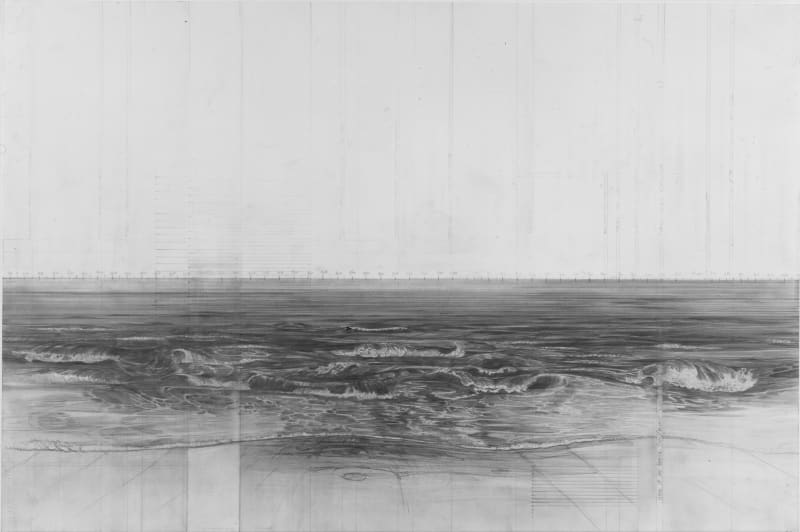Evence Verdier in her article on the artist, "Hans Op de Beeck, Le crépuscule des illusions", published in Art Press in September 2005, describes the exhibition at the gallery Les filles du Calvaire in Paris on September 2004 as "a metaphor for drawing: (...) The video projection Perte (2004) showed, among other images, waves whose progression led to the center of the exhibition space. There was a basin similar to the water lily pond also mentioned in the film. This sculpture appeared to have washed up on the shore of the video, and the black and white exhibition resembled a three-dimensional drawing in which the viewer was responsible for bringing the color (...) ."
The next part of the exhibition, on the second floor, continued on the same principle, the spectator being welcomed by a video composed of an animation of photographs of gardens, digitally reworked as black and white watercolors, and a soundtrack that echoed the one on the lower floor. In the background, a huge photograph of the wave stopped the visitor and sent him back to the video below. On the side, underlined by a weak lighting, floated large drawings, like memorial traces, symbolic moments of the whole.
The more one penetrates the universe of Hans Op de Beeck, the more one understands that drawing is at the heart of his work, because it is undoubtedly the ideal expression to update his artistic universe, most of the works being imaginary situations. As primary elements, they are used as sketches that can be seen in the critical texts of the 2001 catalogue1 . In the videos, they are sometimes the raw material and are mounted in animation Gardenning I (2001) and Places -(Gardening II) (2004), My Brothers Gardens (2003), they inspire related works such as the digitally watercolored photographs of Loss, (2004), they are not far from the black and white and very "graphite" photographs like the one of the wave of Loss, of which there is moreover a drawing version, they take a third dimension in the models and are also found in the folds of the polyester sculptures or in the tracing of the resins of the water lilies of the pond of Loss. In short, drawing is everywhere, inescapable, and yet silent, like a guardian of the artistic secret, of the thought of the work.
During an interview, with journalists of contemporary art, somewhat disconcerted, the artist evoked Vermeer and the importance of the immersion in the details of his paintings, in the subtlety of the light, and in this miraculous moment has never been frozen by the gesture of the painter and, which, however, remains so open to the navigation of the spirit... Is it by or thanks to this ancestral technique that this Flemish artist wants at all costs to stop the gaze and the thought? It is in any case obvious that it marks by its quasi-classical invoice a will of historical continuity in the practice of the artist while, at the same time, the use that he makes of it gives him an ultra contemporary value. But above all, it is the key to the distanced universe of this man from the North who constantly sends us back to our inner self, sometimes with an ounce of melancholy but always with a touch of ironic shift.
To conclude, let's quote Evence Verdier's article: (...) as in each of his proposals, the experience of the suspended time is not an escape, but the occasion "of a deep way of feeling", which favors the work of conceptualization to which the spectator is invited. In the light of the video Places (Gardening II), a digital animation of the artist's drawings in which the landscape is constantly transformed by a succession of crossfades, it is less a question of showing images than of representing the time of passage and the possibility of reformulating things. What better than the drawing or the model or the twilight could evoke this search for the instability of meaning that characterizes the work of Hans op de Beeck?

